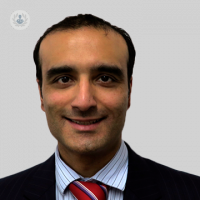Treatment and monitoring of patients with prostate cancer: Expert insight on current approaches
Escrito por:Highly esteemed consultant urological surgeon Mr Vivek Wadhwa shares an in-depth guide to the various treatment modalities available for patients with prostate cancer in his second article in this informative series. Mr Wadhwa additionally sheds light on the associated side effects of prostate cancer treatment and expertly explains how specialists determine the stage and aggressiveness of a patient’s prostate cancer.

What are the most effective treatments for prostate cancer?
This depends on the individual case because you have to ascertain if the cancer is localised (prostate cancer within the prostate), has spread locally, or is metastatic.
For localised prostate cancer, one option would be active surveillance where low grade, low stage prostate cancer may not even need treatment. It's possible that before PSA screening, these patients would have lived their whole life without ever knowing they had prostate cancer. If you do some form of radical treatment, they could end up with complications from it, even though the cancer itself would never have would have never affected them. For most patients with low grade, low stage prostate cancer, we should offer active surveillance where we just keep an eye on the PSA and consider repeating the MRI and biopsy after one year.
Obviously, this approach wouldn't be appropriate for intermediate or high risk prostate cancers. In such cases, one option would be surgery to remove the prostate using an open, laparoscopic (keyhole) or robotic technique. Our aim in this type of surgery is to achieve what we call the trifecta:
- to remove all of the cancer
- to preserve the nerves so that the patient can retain their continence and won't leak urine
- to preserve potency that enables them to have an erection
Another treatment option is radiotherapy. Some patients undergo radical radiotherapy, where they attend a radiotherapy unit once a day for so many days, in discussion with their oncologist. Brachytherapy is another possible form of treatment for small volume prostates with intermediate risk, where you implant radioactive seeds into the prostate. There are also new treatments such as HIFU (high intensity focused ultrasound), where you destroy small sections of the prostate which include the cancer. Studies are ongoing but these are the main treatments available to date.
How is the stage and the aggressiveness of prostate cancer determined?
As I mentioned in my other article on prostate cancer diagnosis, after the prostate biopsy, we grade the cancer depending on the architecture of the cells according to the Gleason score. On the Gleason score, anything from 0 to 5 is normal, (not cancer).
Gleason six is low grade and the least aggressive type of cancer - what we call a pussycat - whereas Gleason ten is a very aggressive cancer, which we would call a tiger. Generally, six is low grade and seven, depending on its type, can be intermediate, whereas eight, nine and ten tend to be aggressive.
We establish the stage of the cancer by looking at the staging scans, which allow us to ascertain how spread the prostate cancer is. This is called TNM staging. T is local stage; N is lymph node stage; M is metastasis.
- T1: no tumour is felt on the rectal examination but cancer is found in prostate tissue (generally from a TURP operation)
- T2: is when the tumour is felt on rectal examination or seen on imaging, within the less than half of the prostate (T2A) or more than half the prostate but not both lobes (T2B), or both lobes (T2C)
- T3: the cancer has gone beyond the prostate and may have grown into your seminal vesicles, which are glands outside the prostate
- T4: it's gone beyond into other structures, maybe the rectum, the bladder or wall of the pelvis
We discuss all of this information in the cancer MDT (multidisciplinary team) meeting which we have once a week at University Hospital Birmingham. In an MDT meeting, a number of urology surgeons sit down with some pathologists, radiologists and urology clinical nurse specialists (CNS) and we discuss each new case together.
What are the potential side effects of prostate cancer treatment?
With surgery, we look at the trifecta in terms of outcomes and this all depends on the scans. If the scans have shown that the cancer is breaching the prostate capsule or is going near the area where the nerves are, the surgeon has to be more aggressive. This is because the tumour has to be fully removed but, if possible, we want to preserve the nerves so that you preserve the potency for the patient so they don't develop erectile dysfunction, as well as the patient’s continence so they don’t experience leaking. Those are two main side effects of surgery but as we also know, surgery is not without risk.
In this type of procedure, you are removing the prostate as well as stitching (anastomosing) the urethra to the bladder, so there's always a risk of an anastomotic leak. Much like any surgery, there is also a risk of pain, bleeding, infection, heart attack, stroke, pulmonary embolism, DVT and Covid-19, amongst other problems.
Radiotherapy is not without risk itself, and although the treatment aims to only reach the prostate, there may be a bit of scatter which can cause side-effects. If radiotherapy scatters onto the bowel, patients can get a bit of bloody diarrhoea and you can get erectile dysfunction, tiredness, lethargy and neutropenia, amongst other problems.
Generally, our patients will sit down with a urology CNS, who will go through all of the options available. They may also see a consultant pelvic surgeon to consider prostatectomy or a consultant pelvic oncologist to discuss radiotherapy. If the patient is ambivalent, the CNS may well send them to see both and then the patient can make their own decision. Each specialist doctor will explain the pros and cons of each modality, giving the patient sufficient information to make their decision about which type of treatment suits them best.
Which strategies are used to monitor and manage patients with prostate cancer? What would be your recommendations for these patients?
In patients undergoing active surveillance, there is a long term relationship with the urologist and we keep an eye on the PSA through testing every 3 to 4 months. Every so often, we might also do a rectal exam and perhaps at a year's time, we may repeat the MRI scan and do a further biopsy because we want to know if it is safe to continue with active surveillance or if some intervention is required. If the prostate cancer progresses, we can catch it at an early stage while it's still localised and then offer radical treatment, whether it be surgery or radiotherapy.
In patients who undergo surgical removal of the prostate, the PSA should become undetectable. We normally go through follow-ups with these patients every six months or so, which doesn’t always necessitate a hospital visit as CNS can monitor patients’ PSA. In post-surgery patients, we generally like the PSA to remain below 0.2, whereas in patients who have undergone radiotherapy, the PSA should be remain less than 2.0. These patients are also followed up every six months or so, which may be done by an oncologist, a urologist or a urologist CNS. If there’s any significant rise in the PSA, patients are referred back to the MDT and they may have some staging scans and undergo further treatment if required.
This long term relationship is key as we must keep an eye on the patient’s PSA going forward so that if there is any further development of the disease, it can be treated early and give the best possible outcome.
For more detailed insight on the risk factors associated with prostate cancer and what the diagnostic process entails, take a look at Mr Wadhwa’s other informative article in this series.
If you are concerned about your prostate health and would like to schedule a consultation with Mr Wadhwa, you can do so by visiting his Top Doctors profile.


